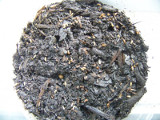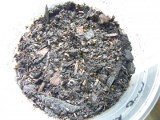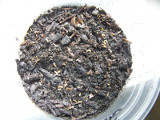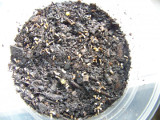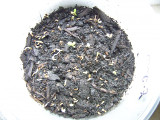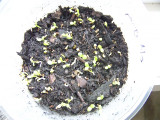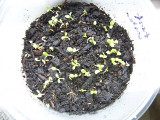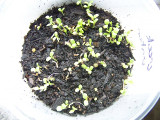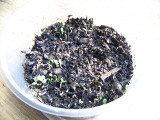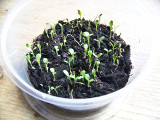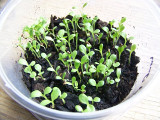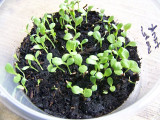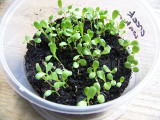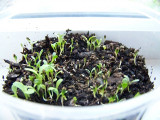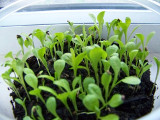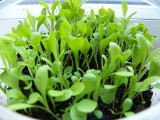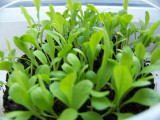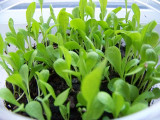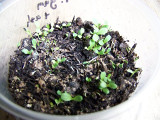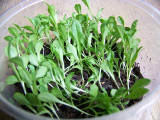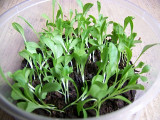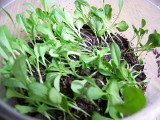Experiment 1
In this first experiment I prepare Eucalyptus tannin water by two methods. One using putrified gum leaves that have accumulate in my guttering, and the other by bottling fresh green gum leaves in water.
After bottling the two samples and topping up the water to the top of the jar, both jars are sealed and left in a shady locality for about one month.
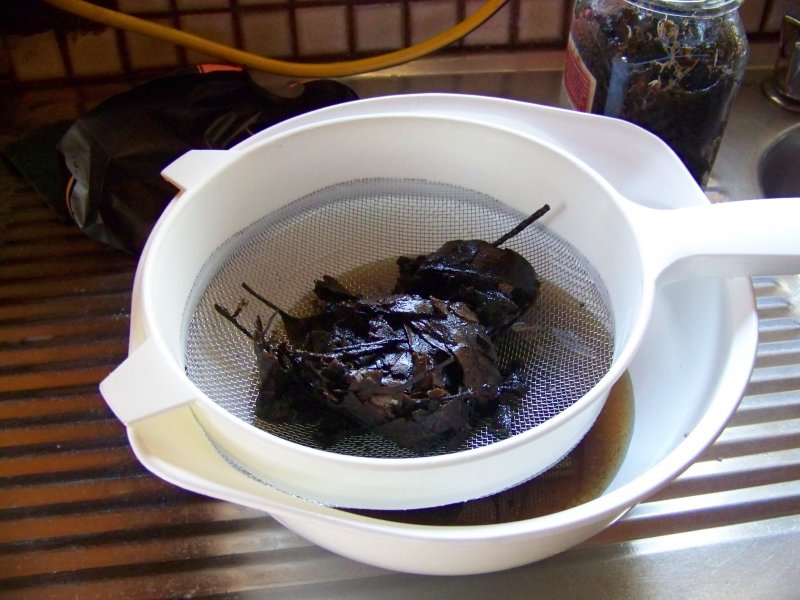
Straining out water from bottled putrified gum leaves sourced from guttering
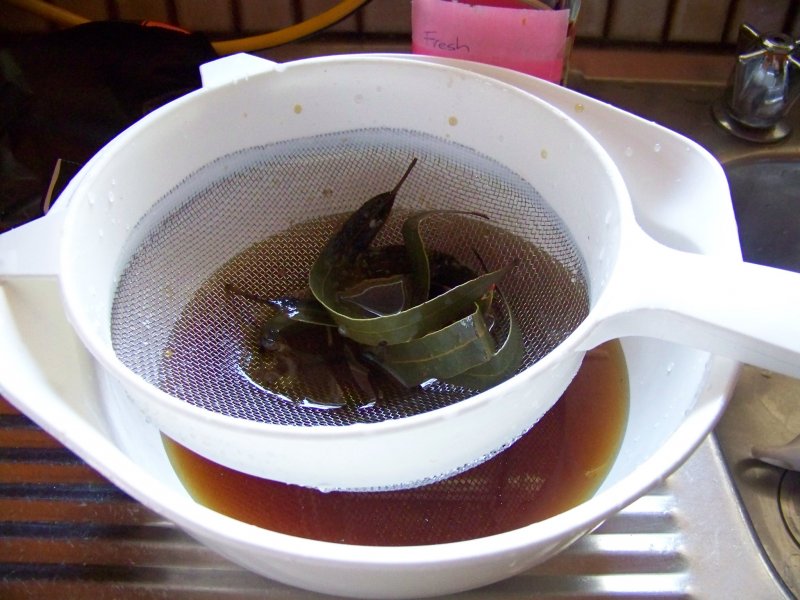
Straining out water from bottled fresh gum leaves
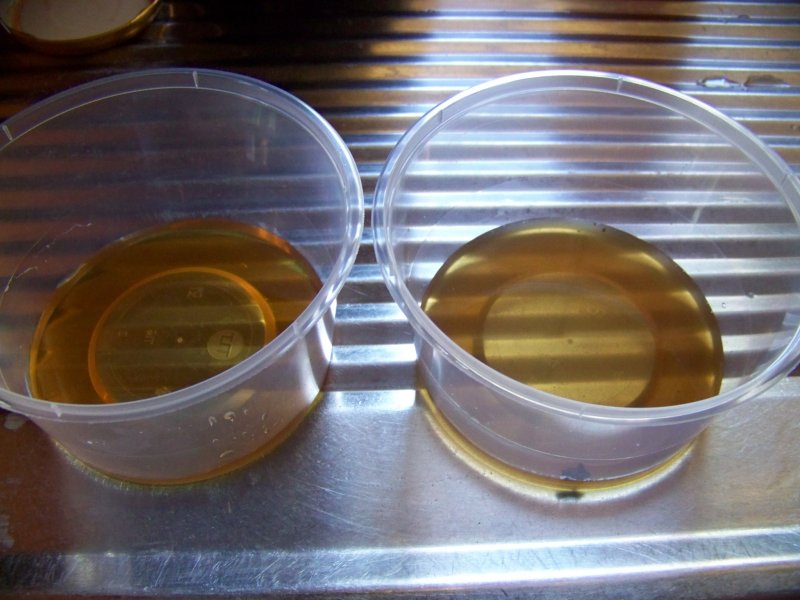
Water from fresh gum leaves left, water from putrified gum leaves on the right.
The putrified gum leaves produced a cloudy brown water, while the fresh gum leaves produced a clear brown water. The former smelled like sewerage, while the water from the fresh gum leaves had a pleasant odour not unlike Kombucha. It would seem some fermentation by lactobacillus bacteria had occurred in the bottle of fresh gum leaves. I was nearly tempted by taste it!
Five small container of potting mix were prepared with Chicory seeds sprinkled on the top. These pots do not drain so will hold their water.
The four scenarios being tested are:
1./ Chicory seed in with a little wood ash and mineral supplements with fresh gum-water.
2./ Chicory seed with fresh gum-water
3./ Chicory seed with putrified gum-water
4./ Chicory seed in tank water (from house tap)
5./ Chicory seed in creek water (from local creek)
see figure 1 below:
Samples 4 & 5 represent the experiment controls, two different water sources are used for the possibility that even the tank water we collect from our roof could have enough gum-leaf toxins to inhibit growth.
Sample 1 has added wood-fire ash (about 1 tsp) and a pinch of a mineral-only plant supplement containing trace minerals (valagro), Boron, Copper, Iron, Magnesium, Molybdomen, Zinc. The idea is to see if the liming effect and minerals have any effect on the growth inhibition of the gum-toxins (as in a post-bushfire scenario). This pot will be compared to Sample 2 which is only fresh gum leaf water.
Sample 3 using the putrified gum water will test to see if old gum leaves do still leach out growth inhibitors, and will be compare to the clean water controls and the fresh-gum leaf pot.
figure 1. Chicory seeds after 2 days
Click above thumbnails for larger image.
For the first day, the tubs had their lids left on to moisturize the seeds.
After 2 days, the seeds in the controls, samples 4 and 5 show significant signs of germination.
figure 2. Chicory seeds after 4 days
Click above thumbnails for larger image.
After 4 days, the germination growth in the controls and the putrified gum-leaf water is significantly greater than the germination growth in the two samples with fresh gum-leaf water.
The chicory seeds however are still germinating in all the pots and there is no sign that the fresh gum-leaf water is doing anything other than slowing down the germination process. Wood-ash is clearly not having any effect at this stage.
figure 3. Chicory seeds after 7 days
After seven days it is clear that wood-ash is not helping counter the effects of gum-leaf toxins. It is clearly doing the worst. It may be that the alkalinity and salinity of the ash is far too much, however I am intrigued as to the possibility that ash is accentuating the growth inhibitory effect of gum-leaf toxins. Further experimentation here is warranted. The putrified gum water is not showing any toxic effects compared to controls, and the fresh gum-leaf pot is still showing a slower germination and growth rate, but no other problems as yet.
After photographing, the pots have been re-watered with their respective solutions- this is the first watering they have received since day one. It is planned now that the pots will receive no more water and will slowly dry out till the end of the experiment. This will test the hypothesis that the gum toxic effect will become more pronounced as moisture levels decrease. Field observations seem to suggest plants under gums are far more susceptible to drying.
figure 4. Chicory seeds after 14 days
After 14 days the same pattern continues. The pots have not been watered since last observation, but have not dried out yet so are still not under any water stress.
Given so far the results of this experiment have not been spectacular, it is worthwhile to consider consider the big confounding variable that may render this experiment meaningless: the acidity of the treatment solution.
I have already mentioned the solution prepared from fresh gum leaves had a pleasant kombucha smell, meaning that some lacto-fermentation had occurred. This is the same process that occurs in a jar of sauerkraut.
Using an Oakton PH measurement instrument calibrated a few weeks ago I get the following readings:
It is clear that the solution prepared from fresh gum leaves is very acidic compared to all the other samples! This factor alone would explain the slower growth in this pot, and suggest that I have not been able to extract any significant amounts of allelopathic chemicals from the gum leaves.
Quite clearly this is contrary to my original hypothesis.
Then how about the pot with the ash? Ash is alkaline and would have neutralised the acidity of the lactic-acid surely?
Indeed, when mixing a teaspoon of fire-wood ash with the fresh gum water, in roughly the original quantity used, I end up with a solution with a PH of about 6.8. This is fairly close to neutral. After a few minutes I retest the solution, and the PH has increased to 8.3 and is slightly alkaline.
In the process of neutralising each other, the solution has become saline with calcium, potassium and sodium cations and lactate and bicarbonate anions.
It is not possible to determine this salinity, but it can be indirectly measured by electrical conductivity (Oakton device calibrated in the last month). The resultant solution has electrical conductivity of 4.5 mS/m. This is equivalent to about one teaspoon of salt in 2 litres of clean water. This does not seem to be very high, but with other solutes already in the potting mix, plus a pinch of chelated trace minerals, it would likely have been outside the preferred range for chicory seedlings.
figure 6. Chicory seeds after 17 days
This is the final shot of the chicory, and shows the effect of drying out on the seedlings. This is the final nail in the hypothesis, with the fresh-gum leaf watered pot showing in fact less water stress than the controls. This would be explained by the fact that the plants had used less water. Nevertheless, there is no obvious sign that tannin water from fresh gum leaves makes chicory more susceptible to water stress.
This experiment has failed to demonstrate the allelopathic effect of Eucalyptus through a water soluble medium. The small effect observed was most likely caused by the acidity of the water from lacto-fermentation of the sugars in the gum leaves.
It is quite likely that many other experiments which have used a similar methodology have also mistaken lactic acid effect for eucalyptus allelopathy. This is not to say that Eucalypts are not allelopathic, but that these allelopathic chemicals are probably associated with the oils and not the water-soluble tannins.
After bottling the two samples and topping up the water to the top of the jar, both jars are sealed and left in a shady locality for about one month.

Straining out water from bottled putrified gum leaves sourced from guttering

Straining out water from bottled fresh gum leaves

Water from fresh gum leaves left, water from putrified gum leaves on the right.
The putrified gum leaves produced a cloudy brown water, while the fresh gum leaves produced a clear brown water. The former smelled like sewerage, while the water from the fresh gum leaves had a pleasant odour not unlike Kombucha. It would seem some fermentation by lactobacillus bacteria had occurred in the bottle of fresh gum leaves. I was nearly tempted by taste it!
Five small container of potting mix were prepared with Chicory seeds sprinkled on the top. These pots do not drain so will hold their water.
The four scenarios being tested are:
1./ Chicory seed in with a little wood ash and mineral supplements with fresh gum-water.
2./ Chicory seed with fresh gum-water
3./ Chicory seed with putrified gum-water
4./ Chicory seed in tank water (from house tap)
5./ Chicory seed in creek water (from local creek)
see figure 1 below:
Samples 4 & 5 represent the experiment controls, two different water sources are used for the possibility that even the tank water we collect from our roof could have enough gum-leaf toxins to inhibit growth.
Sample 1 has added wood-fire ash (about 1 tsp) and a pinch of a mineral-only plant supplement containing trace minerals (valagro), Boron, Copper, Iron, Magnesium, Molybdomen, Zinc. The idea is to see if the liming effect and minerals have any effect on the growth inhibition of the gum-toxins (as in a post-bushfire scenario). This pot will be compared to Sample 2 which is only fresh gum leaf water.
Sample 3 using the putrified gum water will test to see if old gum leaves do still leach out growth inhibitors, and will be compare to the clean water controls and the fresh-gum leaf pot.
figure 1. Chicory seeds after 2 days
Click above thumbnails for larger image.
For the first day, the tubs had their lids left on to moisturize the seeds.
After 2 days, the seeds in the controls, samples 4 and 5 show significant signs of germination.
figure 2. Chicory seeds after 4 days
Click above thumbnails for larger image.
After 4 days, the germination growth in the controls and the putrified gum-leaf water is significantly greater than the germination growth in the two samples with fresh gum-leaf water.
The chicory seeds however are still germinating in all the pots and there is no sign that the fresh gum-leaf water is doing anything other than slowing down the germination process. Wood-ash is clearly not having any effect at this stage.
figure 3. Chicory seeds after 7 days
After seven days it is clear that wood-ash is not helping counter the effects of gum-leaf toxins. It is clearly doing the worst. It may be that the alkalinity and salinity of the ash is far too much, however I am intrigued as to the possibility that ash is accentuating the growth inhibitory effect of gum-leaf toxins. Further experimentation here is warranted. The putrified gum water is not showing any toxic effects compared to controls, and the fresh gum-leaf pot is still showing a slower germination and growth rate, but no other problems as yet.
After photographing, the pots have been re-watered with their respective solutions- this is the first watering they have received since day one. It is planned now that the pots will receive no more water and will slowly dry out till the end of the experiment. This will test the hypothesis that the gum toxic effect will become more pronounced as moisture levels decrease. Field observations seem to suggest plants under gums are far more susceptible to drying.
figure 4. Chicory seeds after 14 days
After 14 days the same pattern continues. The pots have not been watered since last observation, but have not dried out yet so are still not under any water stress.
Given so far the results of this experiment have not been spectacular, it is worthwhile to consider consider the big confounding variable that may render this experiment meaningless: the acidity of the treatment solution.
I have already mentioned the solution prepared from fresh gum leaves had a pleasant kombucha smell, meaning that some lacto-fermentation had occurred. This is the same process that occurs in a jar of sauerkraut.
Using an Oakton PH measurement instrument calibrated a few weeks ago I get the following readings:
| Sample | PH |
|---|---|
| Fresh Gum Water | 4.1 |
| Old Gum Water | 6.2 |
| Creek Water | 7.2 |
| Tank Water | 6.3 |
It is clear that the solution prepared from fresh gum leaves is very acidic compared to all the other samples! This factor alone would explain the slower growth in this pot, and suggest that I have not been able to extract any significant amounts of allelopathic chemicals from the gum leaves.
Quite clearly this is contrary to my original hypothesis.
Then how about the pot with the ash? Ash is alkaline and would have neutralised the acidity of the lactic-acid surely?
Indeed, when mixing a teaspoon of fire-wood ash with the fresh gum water, in roughly the original quantity used, I end up with a solution with a PH of about 6.8. This is fairly close to neutral. After a few minutes I retest the solution, and the PH has increased to 8.3 and is slightly alkaline.
In the process of neutralising each other, the solution has become saline with calcium, potassium and sodium cations and lactate and bicarbonate anions.
It is not possible to determine this salinity, but it can be indirectly measured by electrical conductivity (Oakton device calibrated in the last month). The resultant solution has electrical conductivity of 4.5 mS/m. This is equivalent to about one teaspoon of salt in 2 litres of clean water. This does not seem to be very high, but with other solutes already in the potting mix, plus a pinch of chelated trace minerals, it would likely have been outside the preferred range for chicory seedlings.
figure 6. Chicory seeds after 17 days
This is the final shot of the chicory, and shows the effect of drying out on the seedlings. This is the final nail in the hypothesis, with the fresh-gum leaf watered pot showing in fact less water stress than the controls. This would be explained by the fact that the plants had used less water. Nevertheless, there is no obvious sign that tannin water from fresh gum leaves makes chicory more susceptible to water stress.
This experiment has failed to demonstrate the allelopathic effect of Eucalyptus through a water soluble medium. The small effect observed was most likely caused by the acidity of the water from lacto-fermentation of the sugars in the gum leaves.
It is quite likely that many other experiments which have used a similar methodology have also mistaken lactic acid effect for eucalyptus allelopathy. This is not to say that Eucalypts are not allelopathic, but that these allelopathic chemicals are probably associated with the oils and not the water-soluble tannins.


